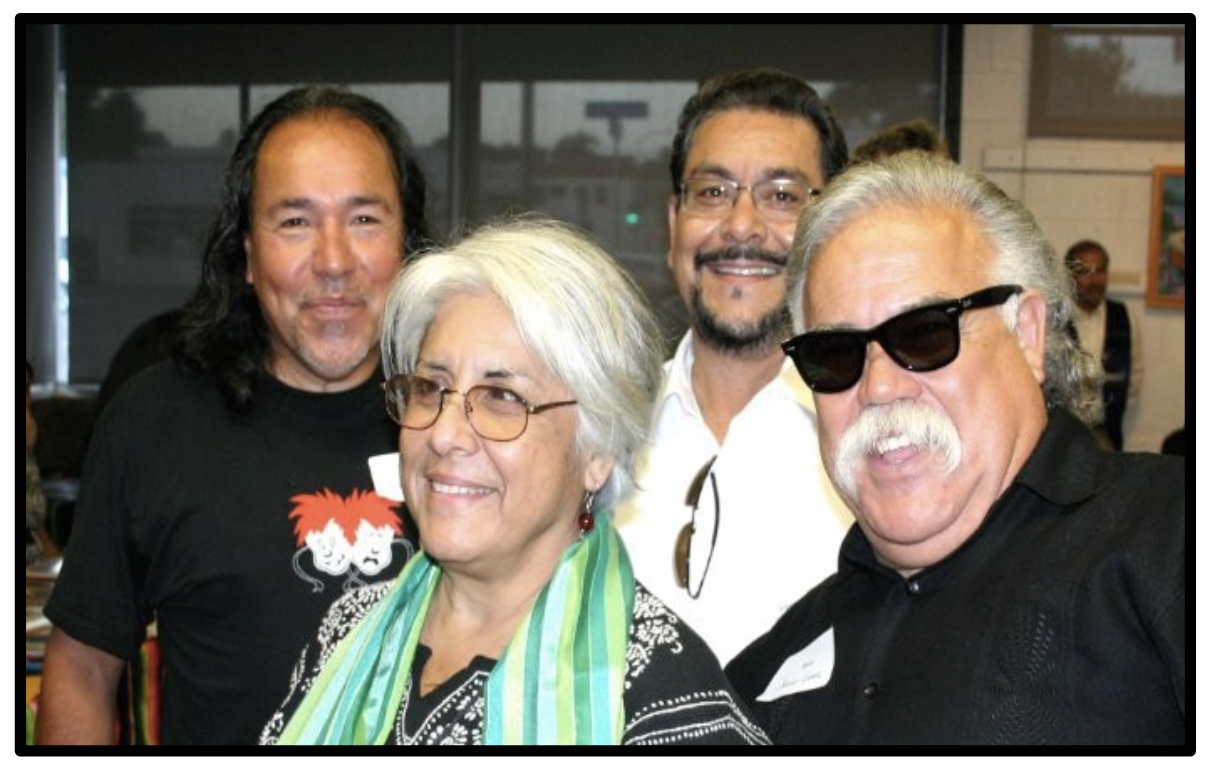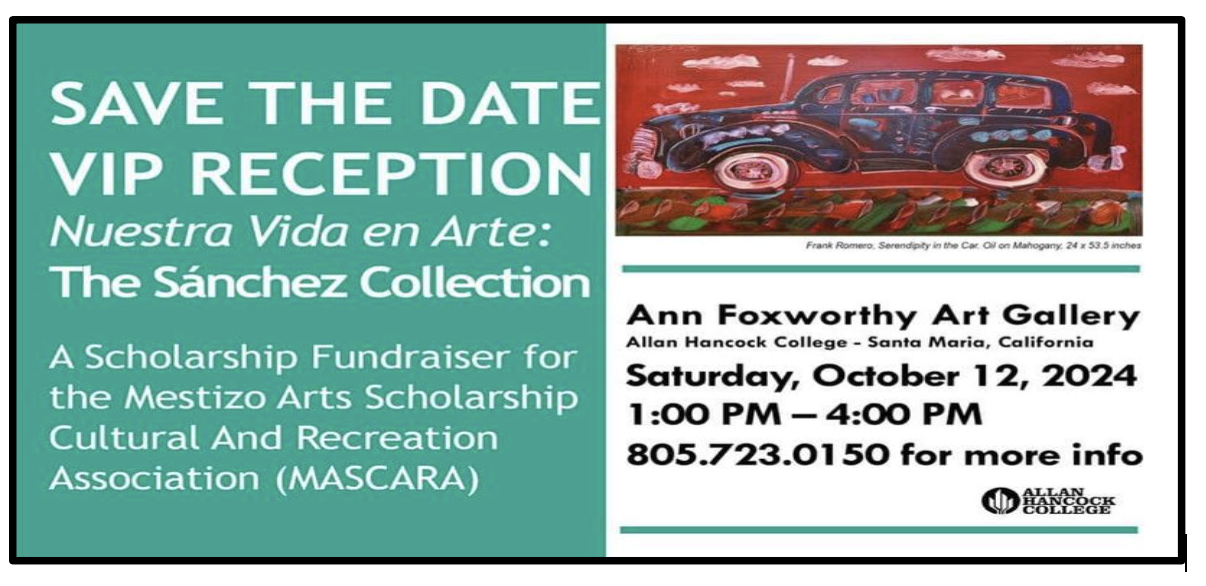
Armando Vazquez, Margaret Garcia, Ben Saiz, Javier Gomez, Artists, Activists and Homies from CSUN y mas alla. Courtesy photo.
Editor’s note: Amigos805 welcomes guest columns, letters to the editor and other submissions from our readers. All opinions expressed in submitted material are those of the author and do not necessarily represent the viewpoint of Amigos805.
By Armando Vazquez , M.Ed. / Guest contributor
The Mexican/Chicano Art Movimiento is the incontrovertible revolutionary progeny of the Mexican Revolutionary artists, and as such the continuation of the most influential art movement of the 20th century. The Mexican Revolution began in 1910 and is recognized as the first major political proletariat led uprising and revolution of the 20th century. At the vanguard of the Mexican Revolution where warrior peasants like Villa, Zapata y Las Adelitas, intellectuals like Jose Vasconcelos and artists like Jose Posada and Francisco Goitia all working to overthrow the brutal dictatorship of Porfirio Diaz. It is during this protracted and bloody civil war, and the turbulent years of reconciliation that follow that the Mexican artists would take the center stage in documenting the painful and often sputtering transformation of Mexico from tyranny to a fledgling democracy, and documenting through scathing art the social justice, equality, and democratic aspiration of Mexico in the 20th century world.
In a recent article by Natasha Gural, a multiple award-winning journalist, explores the groundbreaking exhibition “Vida Americana: Mexican Muralists Remake American Art,” which opened at the Whitney Museum of American Art in New York on February 17, 2020. Gural quotes Barbara Haskell, the renowned art historian and curator of the exhibition, stating, “The Mexican artists had the most profound and pervasive influence on American art of the 20th century.”
World renowned art historian Barbara Haskell and Armando Vazquez, Chicano artist, writer, and curator from Santa Maria, California concur and thus we begin to dismiss and dismantle the elitist Eurocentric myth that the French, or the Germans, or the Spanish; or in fact any and all art that emanating in Europe had the greatest impact on artists of the Americas and the world. Haskell research of over 10 years for the preparation of the Vida Americana exhibit, and led her to conclude that 20th century Mexican art is, “an epic, socially moving document” that influenced the 20th century art world, “South to North, rather than East to West”.
The Vida Americana exhibition features over 200 works by more than 60 artists, both Mexican and internationally renowned, influenced by Mexican maestros like Diego Rivera, José Clemente Orozco, and Frida Kahlo. Notable artists include David Alfaro Siqueiros, María Izquierdo, Rufino Tamayo, Miguel Covarrubias, Thomas Hart Benton, Elizabeth Catlett, Aaron Douglas, Jackson Pollock, and many others.
The Mexican Revolution and Chicano Movimiento, born from war’s bloodshed and the fight for equality and liberation, they used art as a vital communication tool. For over half a century, Chicano artists have documented this struggle, creating what Barbara Haskell calls “an epic, socially moving document.” Prominent artists like Carlos Almaraz, Pattsi Valdez, Frank Romero, Judith Baca, Margaret Garcia, Joe Bravo, David Flurry and many others have continued this artistic legacy in the United States.
 The Sanchez Family Chicano Art Collection at Hancock College:
The Sanchez Family Chicano Art Collection at Hancock College:
If you have been an astute and passionate buyer/collector of Chicano art, then you are in the enviable position of owning some of the most influential and important contemporary art in the world today. Nothing creates community awareness, pride and progressive civic direction and economic development faster than a culturally sensitive and congruent art and cultural scene in a local community struggling for identity.
Showcasing The Sánchez Collection is a crucial first step in creating a vibrant, diverse, inclusive, and culturally congruent fine arts scene in the greater Santa Maria area. This initiative not only highlights the rich cultural heritage of our community but also fosters a more inclusive environment where diverse voices and perspectives are celebrated.
As a long-life artist and previous co-owner of a cultural arts center, I am thrilled to share that the Mestizo Arts Scholarship Cultural And Recreation Association (MASCARA) invited me to participate as a guest curator for an exciting Chicano art exhibition. This exhibition opens October 14, 2024, at the Ann Foxworthy Art Gallery at Hancock College in Santa Maria.
In collaboration with the Fine Arts Department, MASCARA and Allan Hancock College will curate and host a two-month-long, world-class Chicano art exhibit featuring the renowned Sánchez Collection. This event promises to be a significant cultural milestone, showcasing the rich heritage and artistic contributions of the Chicano community.
For over three decades, I have tirelessly sought the support of city officials and politicos in Santa Maria, Ventura, and Oxnard to transform one of the many abandoned buildings in the downtown area into a Chicano/Latino Art Museum. Despite my efforts, my appeals have often fallen on culturally tone-deaf ears. However, I remain undeterred in my mission to establish multiple Chicano/Latino Art Galleries and Museums in Santa Maria Valley or other Southern California communities.
These culturally and ethnically congruent art institutions are desperately needed in our communities. They serve to educate, inform, inspire, and activate the next wave of Chicano artists and activists. By continuing to utilize the arts as one of the most powerful and transformative weapons of the 20th century, we can work towards equality and social justice for all.
Art has always been a vital tool for social change. It has the power to challenge perceptions, evoke emotions, and inspire action. In our communities, Chicano/Latino Art Museums and Galleries can play a crucial role in fostering a sense of identity and pride. They can provide a platform for artists to express their experiences and perspectives, and for the community to engage with and appreciate these expressions.
The establishment of these institutions is not just about preserving and showcasing art; it is about creating spaces where culture and history are celebrated, where dialogue and understanding are promoted, and where future generations can be inspired to continue the fight for social justice. It is about recognizing the value of our cultural heritage and ensuring that it is accessible to all.
I will not stop in my efforts to make this vision a reality. The need for these art and cultural institutions is too great, and the potential impact too significant, to give up. Together, we can create a future where the arts are a central part of our communities, and where the voices of Chicano artists and activists are heard and valued.
— Armando Vazquez, M.Ed. is executive director of the Acuna Arts Collective, an activist/artist, writer, art collector, and curator. Vazquez has been writing about Chicano art and culture for more than 50 years. Vazquez is co-curator of the historical Sanchez Family Collection exhibition that will be showcased at the Foxworthy Gallery, Hancock College, Santa Maria, Ca., on October 12,2024
